Sopwith Camel
| Camel | |
|---|---|
 Sopwith Camel | |
| General information | |
| Type | Biplane fighter |
| Manufacturer | Sopwith Aviation Company |
| Designer | |
| Primary users | Royal Flying Corps |
| Number built | 5,490 |
| History | |
| Introduction date | June 1917 |
| First flight | 22 December 1916 |
| Retired | January 1920 |
| Developed from | Sopwith Pup |
The Sopwith Camel is a British First World War single-seat biplane fighter aircraft that was introduced on the Western Front in 1917. It was developed by the Sopwith Aviation Company as a successor to the Sopwith Pup and became one of the best-known fighter aircraft of the Great War. Pilots flying Camels were credited with downing 1,294 enemy aircraft, more than any other Allied fighter of the conflict. Towards the end of the war, Camels lost their edge as fighters and were also used as a ground-attack aircraft.
The Camel was powered by a single rotary engine and was armed with twin synchronized 0.303 in (7.70 mm) Vickers machine guns. It was difficult to fly, with 90% of its weight in the front two metres (seven feet) of the aircraft, but it was highly manoeuvrable in the hands of an experienced pilot, a vital attribute in the relatively low-speed, low-altitude dogfights of the era. Its pilots joked that their fates would involve "a wooden cross, the Red Cross, or a Victoria Cross".
The main variant of the Camel was designated as the F.1. Other variants included the 2F.1 Ship's Camel, which operated from aircraft carriers; the Comic night fighter variant; and the T.F.1, a "trench fighter" armoured for attacks on heavily defended ground targets. A two-seat variant served as a trainer. The last Camels were withdrawn from RAF service in January 1920.
Development
[edit]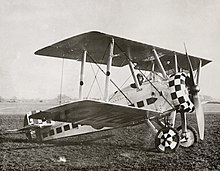
When it became clear the Sopwith Pup was no match for the newer German fighters such as the Albatros D.III, the Camel was developed to replace it,[2] as well as the Nieuport 17s that had been purchased from the French as an interim measure. It was recognised that the new fighter needed to be faster and have a heavier armament. The design effort to produce this successor, initially designated as the Sopwith F.1, was headed by Sopwith's chief designer, Herbert Smith.[3][4]
Early in its development, the Camel was simply referred to as the "Big Pup". A metal fairing over the gun breeches, intended to protect the guns from freezing at altitude, created a "hump" that led pilots to call the aircraft "Camel", although this name was never used officially.[2][5] On 22 December 1916, the prototype Camel was first flown by Harry Hawker at Brooklands, Weybridge, Surrey; it was powered by a 110-horsepower (82 kW) Clerget 9Z.[4]
In May 1917, the first production contract for an initial batch of 250 Camels was issued by the British War Office.[6] Throughout 1917, a total of 1,325 Camels were produced, almost entirely the initial F.1 variant. By the time that production of the type came to an end, approximately 5,490 Camels of all types had been built.[7] In early 1918, production of the naval variant of the Sopwith Camel, the "Ship's" Camel 2F.1 began.[8]
Design
[edit]Overview
[edit]
The Camel had a conventional design for its era, with a wire-braced wooden box-girder fuselage structure, an aluminium engine cowling, plywood panels around the cockpit, and a fabric-covered fuselage, wings and tail. While possessing some clear similarities with the Pup, it had a noticeably bulkier fuselage.[3] For the first time on an operational British-designed fighter, two 0.303 in (7.7 mm) Vickers machine guns were mounted directly in front of the cockpit, synchronised to fire forwards through the propeller disc[4][2] – initially this consisted of the fitment of the Sopwith firm's own synchronizer design, but after the mechanical-linkage Sopwith-Kauper units began to wear out, the more accurate and easier-to-maintain, hydraulic-link Constantinesco-Colley system replaced it from November 1917 onward. In addition to the machine guns, a total of four Cooper bombs could be carried for ground attack purposes.[4]
The bottom wing was rigged with 5° dihedral while the top wing lacked any dihedral; this meant that the gap between the wings was less at the tips than at the roots; this change had been made at the suggestion of Fred Sigrist, the Sopwith works manager, as a measure to simplify the aircraft's construction.[9] The upper wing featured a central cutout section for the purpose of providing improved upwards visibility for the pilot.[10]
Production Camels were powered by various rotary engines, most commonly either the Clerget 9B or the Bentley BR1.[11] In order to evade a potential manufacturing bottleneck being imposed upon the overall aircraft in the event of an engine shortage, several other engines were adopted to power the type as well.[12]
Flight characteristics
[edit]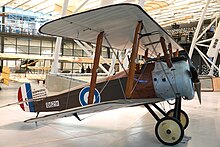
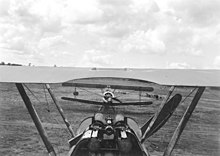
Unlike the preceding Pup and Triplane, the Camel was considered to be difficult to fly.[13] With light and sensitive controls the type owed both its extreme manoeuvrability and its difficult handling to the close placement of the engine, pilot, guns and fuel tank (some 90% of the aircraft's weight) within the front seven feet (2.1 m) of the aircraft, and to the strong gyroscopic effect of the rotating mass of the cylinders common to rotary engines.[Note 1]
Due to the torque of the rotary engine the Camel turned more slowly to the left, which resulted in a nose-up attitude, but the torque also resulted in being able to turn to the right quicker than other fighters,[14] although that resulted in a tendency towards a nose-down attitude from the turn. Because of the faster turning capability to the right, some pilots preferred to change heading 90° to the left by turning 270° to the right.[15]
Upon entering service, the Camel gained an unfortunate reputation with pilots,[16] with inexperienced ones crashing on take-off when the full fuel load pushed the aircraft's centre of gravity beyond the rearmost safe limit.
When in level flight, the Camel was markedly tail-heavy. Unlike the Sopwith Triplane, the Camel lacked a variable incidence tailplane, so that the pilot had to apply constant forward pressure on the control stick to maintain a level attitude at low altitude. The aircraft could be rigged so that at higher altitudes it could be flown "hands off". A stall immediately resulted in a dangerous spin. RFC pilots used to joke that it offered the choice between "a wooden cross, the Red Cross, or a Victoria Cross".[17][15]
A two-seat trainer version was later built to ease the transition process:[18] in his Recollections of an Airman, Lieutenant Colonel L. A. Strange, who served with the central flying school, wrote: "In spite of the care we took, Camels continually spun down out of control when flew [sic] by pupils on their first solos. At length, with the assistance of Lieut Morgan, who managed our workshops, I took the main tank out of several Camels and replaced [them] with a smaller one, which enabled us to fit in dual control." Such conversions, and dual instruction, went some way to alleviating the previously unacceptable casualties incurred during the critical type-specific solo training stage.[16]
Despite these issues, its agility in combat made the Camel one of the best-remembered Allied aircraft of the First World War. Aviation author Robert Jackson notes that: "in the hands of a novice it displayed vicious characteristics that could make it a killer; but under the firm touch of a skilled pilot, who knew how to turn its vices to his own advantage, it was one of the most superb fighting machines ever built".[4]
Operational history
[edit]Western front
[edit]

In June 1917, the Sopwith Camel entered service with No. 4 Squadron of the Royal Naval Air Service, which was stationed near Dunkirk, France; this was the first squadron to operate the type.[19] Its first combat flight and reportedly its first victory claim were both made on 4 July 1917.[6] By the end of July, the Camel also equipped No. 3 and No. 9 Naval Squadrons; and it had become operational with No. 70 Squadron of the Royal Flying Corps.[8] By February 1918, 13 squadrons had Camels as their primary equipment.[20]
The Camel proved in service to have better manoeuvrability than the Albatros D.III and D.V and offered heavier armament and better performance than the Pup and Triplane. Together with the S.E.5a and the SPAD S.XIII, it helped to re-establish the Allied aerial superiority for a time.
While flying a Sopwith Camel with the serial number B6313, the Canadian ace Billy Barker was credited with shooting down 46 aircraft. The total aircraft credited to Barker while flying B6313 is the highest attributed to a single aircraft during World War I.[21]
Home defence and night fighting
[edit]An important role for the Camel was home defence. The RNAS flew Camels from Eastchurch and Manston airfields against daylight raids by German bombers, including Gothas, from July 1917.[18] The public outcry against the night raids and the poor response of London's defences resulted in the RFC deciding to divert Camels that had been heading to the frontlines in France to Britain for the purposes of home defence; in July 1917, 44 Squadron RFC reformed and reequipped with the Camel to conduct the home defence mission.[22] By March 1918, the home defence squadrons had been widely equipped with the Camel and by August 1918, a total of seven home defence squadrons were operating these aircraft.[23]
When the Germans switched to performing nighttime attacks, the Camel proved capable of being flown at night as well.[19] Accordingly, those aircraft assigned to home defence squadrons were quickly modified with navigation lights in order that they could serve as night fighters. A smaller number of Camels were more extensively reconfigured; on these aircraft, the Vickers machine guns were replaced by overwing Lewis guns and the cockpit was moved rearwards so the pilot could reload the guns. This modification, which became known as the "Sopwith Comic" allowed the guns to be fired without affecting the pilot's night vision, and allowed the use of new, more effective incendiary ammunition that was considered unsafe to fire from synchronised Vickers guns.[24][25][Note 2]
The Camel was successfully used to intercept and shoot down German bombers on multiple occasions during 1918, serving in this capacity through to the final German bombing raid upon Britain on the night of the 20/21 May 1918.[27] During this air raid, a combined force of 74 Camels and Royal Aircraft Factory S.E.5s intercepted 28 Gothas and Zeppelin-Staaken R.VIs; three German bombers were shot down, while two more were downed by anti-aircraft fire from the ground and a further aircraft was lost to engine failure, resulting in the heaviest losses suffered by German bombers during a single night's operation over England.[28] IN July 1918 seven Sopwith Camels destroyed by bombing their hangars two German Zeppelins in the Tondern Raid; they were flown off HMS Furious, and then landed in Denmark or ditched in the sea to be picked up.
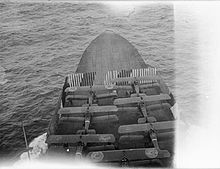
The Camel night fighter was also operated by 151 Squadron to intercept German night bombers operating over the Western Front.[29] These aircraft were not only deployed defensively, but often carried out night intruder missions against German airstrips. After five months of operations, 151 Squadron had claimed responsibility for shooting down 26 German aircraft.[29]
Shipboard and parasite fighter
[edit]
The RNAS operated a number of 2F.1 Camels that were suitable for launching from platforms mounted on the turrets of major warships as well as from some of the earliest aircraft carriers to be built, eg HMS Furious. Furthermore, the Camel could be deployed from aircraft lighters, which were specially modified barges; these had to be towed fast enough that a Camel could successfully take off. The aircraft lighters served as means of launching interception sorties against incoming enemy air raids from a more advantageous position than had been possible when using shore bases alone.
During the summer of 1918, a single 2F.1 Camel (N6814) participated in a series of trials as a parasite fighter. The aircraft used Airship R23 as a mothership.[30]
Ground attack
[edit]By mid-1918, the Camel had become obsolescent as a day fighter as its climb rate, level speed and performance at altitudes over 12,000 ft (3,650 m) were outclassed by the latest German fighters, such as the Fokker D.VII. However, it remained viable as a ground-attack and infantry support aircraft and instead was increasingly used in that capacity. The Camel inflicted high losses on German ground forces, albeit suffering from a high rate of losses itself in turn, through the dropping of 25 lb (11 kg) Cooper bombs and low-level strafing runs.[31] The protracted development of the Camel's replacement, the Sopwith Snipe, resulted in the Camel remaining in service in this capacity until well after the signing of the Armistice.[32]
During the German spring offensive of March 1918, squadrons of Camels participated in the defence of the Allied lines, harassing the advancing German Army from the skies.[31] Jackson observed that "some of the most intense air operations took place" during the retreat of the British Fifth Army, in which the Camel provided extensive aerial support. Camels flew at multiple altitudes, some as low as 500 feet (150 m) for surprise strafing attacks upon ground forces, while being covered from attack by hostile fighters by the higher altitude aircraft.[32] Strafing attacks formed a major component of British efforts to contain the offensive, the attacks often having the result of producing confusion and panic amongst the advancing German forces. As the March offensive waned, the Camel was able to operate within and maintain aerial superiority for the remainder of the war.[32]
Postwar service
[edit]In the aftermath of the First World War, the Camel saw further combat action. Multiple British squadrons were deployed into Russia as a part of the Allied intervention in the Russian Civil War.[32] Between the Camel and the S.E.5, which were the two main types deployed to the Caspian Sea area to bomb Bolshevik bases and to provide aerial support to the Royal Navy warships present, Allied control of the Caspian region had been achieved by May 1919. Starting in March 1919, direct support was also provided for White Russian forces, carrying out reconnaissance, ground attack, and escort operations.[33] During the summer of 1919, Camels of No. 47 Squadron conducted offensive operations in the vicinity of Tsaritsyn, primarily against Urbabk airfield; targets including enemy aircraft, cavalry formations, and river traffic. In September 1919, 47 Squadron was relocated to Kotluban, where its aircraft operations mainly focused on harassing enemy communication lines.[34] During late 1919 and early 1920, the RAF detachment operated in support of General Vladimir May-Mayevsky's counter-revolutionary volunteer army during intense fighting around Kharkiv. In March 1920, the remainder of the force was evacuated and their remaining aircraft were deliberately destroyed to avoid them falling into enemy hands.[34]
Variants
[edit]Camels were powered by several makes of rotary engines:
- Bentley BR1, 150 hp (standard for RNAS aircraft)
- Clerget 9B, 130 hp (standard powerplant)
- Clerget 9Bf, 140 hp
- Le Rhône 9J, 110 hp
- Gnome Monosoupape 9B-2, 100 hp
- Gnome Monosoupape 9N, 160 hp
Sopwith Camel F.1
[edit]The F.1 was the main production version. It was armed with twin synchronised Vickers guns.
Sopwith Camel 2F.1
[edit]
The 2F.1 was a shipboard variant, flown from HMS Furious.[35] It had a slightly shorter wingspan and a Bentley BR1 as its standard engine. Additionally, one Vickers gun was replaced by an overwing Lewis gun to assist in destroying Zeppelins using incendiary ammunition.
Sopwith Camel "Comic" Night fighter
[edit]The "Comic" was a Camel variant designed specifically for night-fighting duties. The twin Vickers guns were replaced by two Lewis guns on Foster mountings firing forward over the top wing, as the muzzle flash of the Vickers guns could blind the pilot. The second reason to use Lewis guns was to facilitate the use of incendiary ammunition because of the risk of using it in synchronized guns. To allow reloading of the guns, the pilot was moved about 12 inches (30 cm) to the rear, and to compensate the fuel tank was moved forward.[36] It served with Home Defence Squadrons against German air raids. The "Comic" nickname was unofficial, and was shared with the night fighter version of the Sopwith 1½ Strutter.
F.1/1
[edit]The F1/1 was a version with tapered wings.
T.F.1
[edit]The T.F.1 was an experimental trench fighter used for development work for the Sopwith Salamander. Its machine guns were angled downwards for efficient strafing, and it featured armour plating for protection.
Trainer
[edit]The trainer variant had a second cockpit behind the normal pilot's position. The weapons were removed, although the hump was sometimes kept.
Operators
[edit]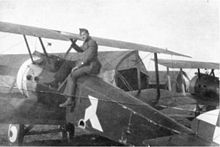
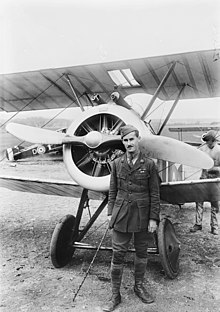
- Australian Flying Corps
- No. 4 Squadron AFC in France.
- No. 5 Squadron AFC in the United Kingdom.
- No. 6 (Training) Squadron AFC in the United Kingdom.
- No. 8 (Training) Squadron AFC in the United Kingdom.
- French Government
- Georgian Air Force - 3-4 aircraft, 1920
- Polish Air Force operated 1 Camel post-war (1921)
- Soviet Air Force - Postwar.
|
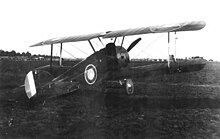
Surviving aircraft
[edit]![]() Media related to Sopwith Camel museum aircraft at Wikimedia Commons
Media related to Sopwith Camel museum aircraft at Wikimedia Commons

There are eight known original Sopwith Camels extant:[42]
- B5747 – F.1 on static display at the Royal Museum of the Armed Forces and Military History in Brussels.[43]
- B6291 – F.1 on display at the National Air and Space Museum's Steven F. Udvar-Hazy Center in Chantilly, Virginia. After being discovered in the 1960s by Desmond St. Cyrien, the aircraft was restored through the 1980s, with the restoration being completed by Tony Ditheridge at AJD Engineering in the United Kingdom, first flying in 1992.[44] From 2005 the aircraft was part of the Javier Arango Collection in Paso Robles, California and was donated to the NASM on Arango's death in April 2017.[45]
- B7280 – F.1 on static display at the Polish Aviation Museum in Kraków, Lesser Poland. The aircraft was built in Lincoln by Clayton & Shuttleworth. On 5 September 1918, when being flown by Captain Herbert A. Patey of No. 210 Squadron RAF over Belgium, it was shot down by Ludwig Beckmann of Jasta 56. Patey survived and was taken prisoner. The Germans repaired the aircraft and flew it until the end of the war. It was then taken to Berlin and exhibited at the Deutsche Luftfahrt Sammlung (German Aviation Collection). During World War II it was moved to Poland for safekeeping, and put into storage. Restoration began in 2007 and was completed by 2010.[46][47]
- C8228 – F.1 on static display at the National Naval Aviation Museum in Pensacola, Florida.[48][49]
- F6314 – F.1 on static display at the Royal Air Force Museum London in London. It was built by Boulton & Paul and is painted to represent an aircraft coded B of No. 65 Squadron RAF.[50][51]
- N6812 – 2F.1 on static display at the Imperial War Museum in London. It was built by William Beardmore and was flown by Flight Sub-Lieutenant Stuart Culley on 11 August 1918 when he shot down Zeppelin LZ 100.[52][53]
- N8156 – 2F.1 on static display at the Canada Aviation and Space Museum in Ottawa, Ontario. Manufactured in 1918 by Hooper and Company Limited, it was purchased by the RCAF in 1925 and last flew in 1967.[54]
- ZK-SDL – F.1 airworthy in New Zealand with The Vintage Aviator Ltd (TVAL)[55] and painted as B5663. It was previously displayed in the Aerospace Education Center in Little Rock, Arkansas, until it closed in December 2010, and the aircraft was sold to help pay debts. The Camel was sold to TVAL and restored to flying condition.[56][failed verification] It was previously registered as N6254.[57]
Reproductions
[edit]![]() Media related to Sopwith Camel replicas at Wikimedia Commons
Media related to Sopwith Camel replicas at Wikimedia Commons

- Replica - F.1 airworthy in Oliver BC Canada, operated as C-FGHT by the Royal Flying Corps School of Aerial Fighting Ltd. Built from Replicraft plans by Rolland Carlson in Wi.Powered by a Warner Super Scarab 165 hp engine.
- Replica – Type T.57 on static display at the Fleet Air Arm Museum at RNAS Yeovilton near Yeovil, Somerset. It was built in 1969 Slingsby for use in a Biggles film. It has a Warner Scarab engine installed and is painted as B6401.[58][59]
- Replica – F.1 on static display at the National Museum of the United States Air Force in Dayton, Ohio. This aircraft was built by museum personnel from original First World War factory drawings and was completed in 1974. It is painted and marked as the Camel flown by Lt. George A. Vaughn Jr. while flying with the 17th Aero Squadron.[60]
- Replica – F.1 airworthy at the Cavanaugh Flight Museum, formerly in Addison, Texas. It was built by Dick Day from original factory drawings. The aircraft is fitted with original instruments, machine guns and an original Gnome rotary engine. It is painted in the scheme of the World War I flying ace Captain Arthur Roy Brown (RAF officer), a Canadian who flew with the Royal Air Force.[61][62] The museum closed indefinitely on 1 January 2024 and announced that its aircraft would be relocated to North Texas Regional Airport in Denison, Texas.[63]
- Replica – F.1 on display at the Brooklands Museum in Weybridge, Surrey. It was built in 1977 by Viv Bellamy at Lands End, as a flyable reproduction for Leisure Sport Ltd. Painted to represent B7270 of 209 Squadron, RAF, the machine which Captain Roy Brown flew when officially credited with shooting down Baron Manfred von Richthofen, it has a Clerget rotary engine of 1916 and was registered as G-BFCZ until 2003. First displayed at the museum in January 1988 for Sir Thomas Sopwith’s 100th birthday celebrations, it was purchased by the museum later that year.[64][failed verification][65][failed verification]
- Replica – B6299 at the Old Rhinebeck Aerodrome in Red Hook, New York. It was completed in 1992 with a 160 hp Gnome Monosoupape model 9N rotary, built by Nathaniel deFlavia and Cole Palen.[66][67] It replaced one of the Dick Day-built and -flown Camel reproductions formerly flown at Old Rhinebeck by Mr. Day in their weekend vintage airshows, which had left the Aerodrome's collection some years earlier.[citation needed]
- Replica – F.1 airworthy with the Javier Arango Collection in Paso Robles, California. It was constructed by Dick Day, is powered by a 160 hp Gnome Monosoupape 9N rotary, and is registered as N8343.[68][failed verification]
- Replica – Unknown airworthy with the Vintage Aviator Collection in Masterton, New Zealand. It was originally built by Carl Swanson for Gerry Thornhill. It is powered by a 160 hp Gnome Monosoupape rotary engine and is painted as B3889.[citation needed]
- Replica – F.1 on static display at the Canadian Museum of Flight in Langley, British Columbia. Lacking an engine, a full reproduction 130 hp rotary engine has been installed.[69]
- Replica – F.1 on static display at the Aviation Heritage Museum in Bull Creek, Western Australia. The engine is original and the propeller is suspected to also be genuine.[70]
- Replica – F.1 airworthy at the Shuttleworth Collection in Old Warden, Bedfordshire. It was built by the Northern Aeroplane Workshops.[71][72]
- Replica – F.1 under construction by Koz Aero in Comstock Park, Michigan. It is based on original factory drawings and using many original parts, including an original engine and instruments.[73][74]
- Replica – F.1 under construction by John S. Shaw. It has an original Clerget 9B 130 CV engine.[75][76]
- Replica – F.1 under construction by John S. Shaw. It has a new build Gnome Monosoupape 9B-2 100 hp engine.[77][78]
- Replica – F.1 on static display at Montrose Air Station Heritage Centre in Montrose, Angus. It is painted and marked as B7320 flown by Captain John Todd of 70 Squadron Royal Flying Corps.[79]
- Replica – F.1 on static display at The Museum of Flight near Seattle Washington.[80]
- Assumed replica - on static display at the Australian Army Flying Museum at Oakley, Queensland. https://www.armyflyingmuseum.com.au/
Specifications (F.1 Camel)
[edit]
Data from Quest for Performance,[81] Profile Publications[82]
General characteristics
- Crew: 1
- Length: 18 ft 9 in (5.72 m)
- Wingspan: 28 ft 0 in (8.53 m)
- Height: 8 ft 6 in (2.59 m)
- Wing area: 231 sq ft (21.5 m2)
- Aspect ratio: 4.11
- Airfoil: RAF 16[83]
- Empty weight: 930 lb (422 kg)
- Gross weight: 1,453 lb (659 kg)
- Zero-lift drag coefficient: CD0.0378
- Frontal area: 8.73 square feet (0.811 m2)
- Powerplant: 1 × Clerget 9B 9-cylinder air-cooled rotary piston engine, 130 hp (97 kW)
- Propellers: 2-bladed fixed-pitch wooden propeller
Performance
- Maximum speed: 113 mph (182 km/h, 98 kn)
- Stall speed: 48 mph (77 km/h, 42 kn)
- Range: 300 mi (480 km, 260 nmi)
- Service ceiling: 19,000 ft (5,800 m)
- Rate of climb: 1,085 ft/min (5.51 m/s)
- Lift-to-drag: 7.7
- Wing loading: 6.3 lb/sq ft (31 kg/m2)
- Power/mass: 0.09 hp/lb (0.15 kW/kg)
Armament
- Guns: 2 × 0.303 in (7.70 mm) Vickers machine guns
Notable appearances in media
[edit]Biggles flies a Sopwith Camel in the novels by W. E. Johns during Biggles's spell in 266 Squadron during the First World War. The first collection of Biggles stories, titled The Camels are Coming, was published in 1932. The first two collections of stories (broken into three books in Australia) were all true stories or events, lightly fictionalised—some of them are identifiable in official war records, e.g., the accidental discovery of a major camouflaged airfield when rescuing a downed pilot.[84]
The Camel is the "plane" of Snoopy in the Peanuts comic strip, when he imagines himself as a World War I flying ace and the nemesis of the Red Baron.[85]
See also
[edit]Aircraft of comparable role, configuration, and era
- Albatros D.V
- Fokker Dr.I
- Fokker D.VI
- Fokker D.VII
- Hanriot HD.1
- Nieuport 24
- Royal Aircraft Factory S.E.5
- SPAD S.XIII
- Vickers F.B.19
Related lists
- List of aircraft of the Royal Air Force
- List of aircraft of the Royal Flying Corps
- List of aircraft of the Royal Naval Air Service
- List of fighter aircraft
References
[edit]Notes
[edit]- ^ As compared with radial engines in which a conventional rotating crankshaft is driven by a fixed engine block.
- ^ The ammunition in question was the RTS (Richard Thelfall and Sons) round, a combined incendiary and explosive round with a nitroglycerin and phosphorus filling. While more effective than earlier incendiary bullets such as the phosphorus-filled Buckingham bullet, they required careful handling, and were initially banned from synchronised weapons, both because of fears about the consequences of bullets striking the propeller of the fighter, and to prevent cooking off of the sensitive ammunition in the chambers of the Vickers guns, which fired from a closed bolt—a required feature for guns used in synchronized mounts—where heat could build up much quicker than in the open bolted Lewis gun.[24][26]
Citations
[edit]- ^ Mason 1992, p. 89.
- ^ a b c Bruce Flight 22 April 1955, p. 527.
- ^ a b Bruce 1965, p. 3.
- ^ a b c d e Jackson 2007, p. 2.
- ^ Bruce 1965, pp. 4-5.
- ^ a b Bruce 1965, p. 5.
- ^ Bruce Flight 29 April 1955, p. 563.
- ^ a b Bruce 1965, p. 6.
- ^ Jon., Guttman (2012). Sopwith Camel. Oxford: Osprey. pp. 9, 16, 30. ISBN 9781780961767. OCLC 775415602.
- ^ Bruce 1965, pp. 3-5.
- ^ Bruce 1968, pp. 148-149.
- ^ Bruce 1965, pp. 7-8.
- ^ Bruce 1965, pp. 5-6.
- ^ Clark 1973, p. 134.
- ^ a b Hoyland, Graham (2021). Merlin: The Power behind the Spitfire, Mosquito and Lancaster. London: William Collins. p. 93. ISBN 978-0-00-835930-0.
{{cite book}}: Unknown parameter|aircraft_type=ignored (help) - ^ a b Jackson 2005, pp. 15–16.
- ^ Leinburger 2008, p. 30.
- ^ a b Bruce 1965, p. 9.
- ^ a b Jackson 2007, p. 3.
- ^ Sturtevant, Ray; Page, Gordon (1993). The Camel File. UK: Air-Britain, Ltd. p. 6. ISBN 0-85130-212-2.
- ^ Franks 2018, p. 89.
- ^ a b Davis 1999, p. 96.
- ^ Davis 1999, p. 98.
- ^ a b Davis 1999, p. 97.
- ^ Bruce 1968, p. 151, 153.
- ^ Williams and Gustin 2003, pp. 11, 14.
- ^ Jackson 2007, pp. 3-6.
- ^ Jackson 2007, p. 6.
- ^ a b Davis 1999, pp. 98–99.
- ^ Fitzsimons, p.521.
- ^ a b Jackson 2007, pp. 7-8.
- ^ a b c d Jackson 2007, p. 8.
- ^ Jackson 2007, pp. 8-10.
- ^ a b Jackson 2007, p. 10.
- ^ "Sopwith 2F.1 Ship's Camel". Their Flying Machines. Retrieved 10 June 2016.
- ^ Mason 1992, p. 91.
- ^ Davis 1999, p. 102.
- ^ "9 Bomb Squadron (ACC)." Archived 27 September 2015 at the Wayback Machine Air Force Historical Research Agency. Retrieved: 19 December 2010.
- ^ "17 Weapons Squadron (ACC)." Archived 25 February 2013 at the Wayback Machine Air Force Historical Research Agency. Retrieved: 19 December 2010.
- ^ "27 Fighters Squadron (ACC)." Archived 23 February 2012 at the Wayback Machine Air Force Historical Research Agency. Retrieved: 19 December 2010.
- ^ "37 Bomb Squadron (ACC)." Archived 25 September 2011 at the Wayback MachineAir Force Historical Research Agency. Retrieved: 19 December 2010.
- ^ "Sopwith Camel". Demobbed - Out of Service British Military Aircraft. 2015. Retrieved 28 July 2015.
- ^ "Airframe Dossier - Sopwith Camel, s/n B5747 RAF". Aerial Visuals. AerialVisuals.ca. Retrieved 12 May 2017.
- ^ "New Aircraft On Display at NASM's Udvar-Hazy Center". Warbirds News. 27 December 2017.
- ^ Glenshaw, Paul. "Javier Arango's Extraordinary Gifts". Air & Space Magazine.
- ^ "Aeroplane: Sopwith F.1 Camel". Polish Aviation Museum. NeoServer. Retrieved 12 May 2017.
- ^ "Lincoln-built Sopwith Camel from the First World War is restored to its former glory". LincolnshireLive. Local World. 22 July 2010. Retrieved 12 May 2017.[permanent dead link]
- ^ "Sopwtih Camel". National Naval Aviation Museum. Naval Aviation Museum Foundation. Retrieved 12 May 2017.
- ^ "Aircraft A5658 Data". Airport-Data.com. Retrieved 12 May 2017.
- ^ "Sopwith F1 Camel". Royal Air Force Museum. Trustees of the Royal Air Force Museum. Retrieved 12 May 2017.
- ^ Simpson, Andrew (2015). "INDIVIDUAL HISTORY [F6314]" (PDF). Royal Air Force Museum. Retrieved 12 May 2017.
- ^ "Sopwith Camel". Imperial War Museums. Retrieved 12 May 2017.
- ^ Ellis 2008, p. 148.
- ^ "SOPWITH 2F.1 SHIP CAMEL". Canada Aviation and Space Museum. Canada Science and Technology Museums Corporation. Archived from the original on 22 July 2017. Retrieved 12 May 2017.
- ^ "Sopwith Camel F.1 3". Civil Aviation Authority of New Zealand. Retrieved 27 March 2021.
- ^ Oman, Noel (16 March 2011). "History Takes Flight: Vintage aircraft sold to pay center's bills". Northwest Arkansas Democrat Gazette. Northwest Arkansas Newspapers LLC. Retrieved 12 May 2017.
- ^ "FAA Registry [N6254]". Federal Aviation Administration. U.S. Department of Transportation. Retrieved 12 May 2017.
- ^ Jackson 1988, p. 349.
- ^ "Sopwith Camel (replica) (B6401)". Royal Navy Fleet Air Arm Museum. Fleet Air Arm Museum. Retrieved 12 May 2017.
- ^ "Sopwith F-1 Camel". National Museum of the US Air Force. 17 July 2015. Retrieved 12 May 2017.
- ^ "Aircraft". Cavanaugh Flight Museum. Retrieved 12 May 2017.
- ^ "FAA Registry [N86678]". Federal Aviation Administration. U.S. Department of Transportation. Retrieved 12 May 2017.
- ^ Sullivan, Cole (1 January 2024). "Historic Addison flight museum announces closure". WFAA. Dallas, Texas. Retrieved 4 January 2024.
- ^ "Sopwith Camel F1 (replica)". Brooklands Museum. Retrieved 12 May 2017.
- ^ "GINFO Search Results [G-BFCZ]". Civil Aviation Authority. Retrieved 12 May 2017.
- ^ "Sopwith Camel". Old Rhinebeck Aerodrome. Archived from the original on 20 December 2016. Retrieved 12 May 2017.
- ^ "FAA Registry [N7157Q]". Federal Aviation Administration. U.S. Department of Transportation. Retrieved 12 May 2017.
- ^ "FAA Registry [N8343]". Federal Aviation Administration. U.S. Department of Transportation. Retrieved 12 May 2017.
- ^ "Sopwith Camel Replica". The Canadian Museum of Flight. Retrieved 27 January 2017.
- ^ "Sopwith F.1 Camel". Aviation Heritage Museum. Retrieved 12 May 2017.
- ^ "Sopwith Camel". Shuttleworth. Retrieved 12 May 2017.
- ^ "Civil Aviation Authority [G-BZSC]". Civil Aviation Authority. Retrieved 12 May 2017.
- ^ Kozura, Tom. "Sopwith F1 Camel". Koz Aero. Retrieved 12 May 2017.
- ^ "FAA Registry [N6557]". Federal Aviation Administration. U.S. Department of Transportation. Retrieved 12 May 2017.
- ^ Shaw, John S. "Sopwith Camel Introduction". John S Shaw Aviation. Retrieved 12 May 2017.
- ^ Shaw, John S. "Le Clerget 9ba rotary engine". John S Shaw Aviation. Retrieved 12 May 2017.
- ^ Shaw, John S. "F-AZZB". John S Shaw Aviation. Retrieved 12 May 2017.
- ^ Shaw, John S. "Gnome". John S Shaw Aviation. Retrieved 12 May 2017.
- ^ "Heritage Centre Layout". Montrose Air Station Heritage Centre. Ian McIntosh Memorial Trust. 21 February 2016. Retrieved 12 November 2018.
- ^ "Sopwith Camel F.1 Reproduction". The Museum of Flight. Retrieved 6 November 2017.
- ^ Loftin, LK, Jr. "Quest for Performance: The Evolution of Modern Aircraft. NASA SP-468". NASA. Retrieved: 22 April 2006.
- ^ Bruce 1965, p. 12.
- ^ Lednicer, David. "The Incomplete Guide to Airfoil Usage". m-selig.ae.illinois.edu. Retrieved 16 April 2019.
- ^ Butts, D (2000). "Biggles – Hero of the Air". In Watkins, T; Jones, D (eds.). A Necessary Fantasy?: The Heroic Figure in Children's Popular Culture. New York: Garland Publishing. pp. 137–152. ISBN 0-8153-1844-8.
- ^ Murphy and McNiece 2003, p. 87.
Bibliography
[edit]- Bowyer, Chaz. Sopwith Camel: King of Combat. Falmouth, Cornwall, UK: Glasney Press, 1978. ISBN 0-9502825-7-X.
- Bruce, J.M. "Sopwith Camel: Historic Military Aircraft No 10: Part I." Flight, 22 April 1955, pp. 527–532.
- Bruce, J.M. "Sopwith Camel: Historic Military Aircraft No 10: Part II." Flight, 29 April 1955. pp. 560–563.
- Bruce, J.M. "Aircraft Profile No. 31. The Sopwith Camel F.1" Profile Publications, 1965.
- Bruce, J.M. War Planes of the First World War: Volume Two Fighters. London:Macdonald, 1968. ISBN 0-356-01473-8.
- Clark, Alan. Aces High: The War In The Air Over The Western Front 1914 - 1918. New York: G. P. Putnam's Sons, 1973. ISBN 0-297-99464-6.
- Cony, Christophe (April 1999). "Une déception: les Sopwith Camel belges" [A Disappointment: The Belgian Sopwith Camels]. Avions: Toute l'aéronautique et son histoire (in French). No. 73. pp. 19–23. ISSN 1243-8650.
- Davis, Mick. Sopwith Aircraft. Ramsbury, Malborough, UK: The Crowood Press, 1999. ISBN 1-86126-217-5.
- Ellis, Ken. Wrecks & Relics, 21st edition. Manchester, UK: Crecy Publishing, 2008. ISBN 978-0-85979-134-2.
- Franks, Norman Images of War - Sopwith Camels Over Italy 1917-18. London: Pen and Sword, 2018. ISBN 1-52672-309-3
- Gerdessen, F (July–August 1999). "Round-Out: More Windfalls". Air Enthusiast. No. 82. pp. 79–80. ISSN 0143-5450.
- Gerdessen, Frederik. "Estonian Air Power 1918 – 1945". Air Enthusiast, No. 18, April – July 1982. pp. 61–76. ISSN 0143-5450.
- Guttman, Jon: "Sopwith Camel (Air Vanguard; 3)". Oxford: Osprey Publishing, 2012. ISBN 978-1-78096-176-7.
- Jackson, A.J. British Civil Aircraft 1919-1972: Volume III. London: Putnam, 1988. ISBN 0-85177-818-6.
- Jackson, Robert. Infamous Aircraft - Dangerous Designs and their Vices. Barnsley, UK:Pen and Sword, 2005. ISBN 978-1-84415-172-1.
- Jackson, Robert. Britain's Greatest Aircraft. Pen and Sword, 2007. ISBN 1-84415-600-1.
- Klaauw, Bart van der (March–April 1999). "Unexpected Windfalls: Accidentally or Deliberately, More than 100 Aircraft 'arrived' in Dutch Territory During the Great War". Air Enthusiast. No. 80. pp. 54–59. ISSN 0143-5450.
- Leinburger, Ralf. Fighter: Technology, Facts, History. London: Parragon Inc., 2008. ISBN 978-1-40549-575-2.
- Mason, Francis K. The British Fighter. London: Putnam, 1992. ISBN 0 85177 852 6
- Murphy, Justin D. and Matthew A. McNiece. Military Aircraft, 1919-1945: An Illustrated History of their Impact. Santa Barbara, California: ABC-CLIO, 2009. ISBN 1-85109-498-9.
- Ralph, Wayne. Barker VC: The Classic Story of a Legendary First World War Hero. London: Grub Street, 1999. ISBN 1-902304-31-4.
- Robertson, Bruce. Sopwith: The Man and His Aircraft. London: Harleyford, 1970. ISBN 0-900435-15-1.
- Sturtivant, Ray and Gordon Page. The Camel File. Tunbridge Wells, Kent, UK: Air-Britain (Historians) Ltd., 1993. ISBN 0-85130-212-2.
- Thomas, Andrew. "In the Footsteps of Daedulus: Early Greek Naval Aviation". Air Enthusiast, No. 94, July–August 2001, pp. 8–9. ISSN 0143-5450
- United States Air Force Museum Guidebook. Wright-Patterson AFB, Ohio: Air Force Museum Foundation, 1975.
- Williams, Anthony G. and Emmanuel Gustin. Flying Guns: World War I and its Aftermath 1914–32. Ramsbury, Wiltshire: Airlife, 2003. ISBN 1-84037-396-2.
- Winchester, Jim, ed. "Sopwith Camel." Biplanes, Triplanes and Seaplanes (Aviation Factfile). London: Grange Books plc, 2004. ISBN 1-84013-641-3.
